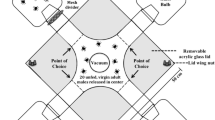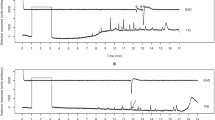Abstract
2,6-Dichlorophenol is the only active sex attractant component detected in the extracts of the Rocky Mountain wood tick,Dermacentor andersoni Stiles and the American dog tick,Dermacentor variabilis (Say). It elicits from the male of each species a hierarchy of responses culminating in copulation. This compound probably occurs generally throughout the metastriate Ixodidae. 2,6-Dibromophenol, an artifact, also elicits the same sexual responses from the wood tick, but phenol andp-cresol do not.
Similar content being viewed by others
References
Berger, R.S. 1972. 2,6-Dichlorophenol, sex pheromone of the lone star tick.Science 177:704–705.
Berger, R.S. 1974. Incorporation of Na36Cl into 2,6-dichlorophenol in lone star and Gulf Coast ticks.Ann. Entomol. Soc. Am. 67:961–963.
Berger, R.S., Dukes, J.C., andChow, Y.S. 1971. Demonstration of a sex pheromone in three species of hard ticks.J. Med. Entomol. 8(1):84–86.
Chow, Y.S., Wang, C.B., andLin, L.C. 1975. Identification of a sex pheromone of the female brown dog tick,Rhipicephalus sanguineus.Ann. Entomol. Soc. Am. 68, 485–488.
Gladney, W.J.,Ernst, S.E., andOehler, D.D. 1971. Demonstration of a sex pheromone in males of the Gulf Coast tick. Unpublished paper presented before The Southwestern Branch Meetings of the Entomol. Soc. Amer., El Paso, Texas. 1971.
Gladney, W.J., Ernst, S.E., andGrabbe, R.R. 1974a. The aggregation response of the Gulf Coast tick on cattle.Ann. Entomol. Soc. Amer. 67(5):750–752.
Gladney, W.J., Ernst, S.E., andOehler, D.D. 1974b. The Gulf Coast Tick: Evidence of a pheromone produced by males.J. Med. Entomol. 11(3):303–306.
Sonenshine, D.E., Silverstein, R.M., Layton, B.C., andHomsher, P.J. 1974. Evidence for the existence of a sex pheromone in 2 species of Ixodid ticks (Metastriata: Ixodidae).J. Med. Entomol. 11(3):307–315.
Wood, W.F., (Sister)Leahy, M.G., Galun, R., Prestwich, G.D., andMeinwald, J. 1975. Phenols as pheromones of Ixodid ticks: a general phenomenon?J. Chem. Ecol. 1(4):501–509.
Author information
Authors and Affiliations
Additional information
Supported by grants nos. AI 10,986 and AI 10,987 from the National Institutes of Allergy and Infectious Diseases, National Institutes of Health, Bethesda, Maryland 20014.
Rights and permissions
About this article
Cite this article
Sonenshine, D.E., Silverstein, R.M., Plummer, E. et al. 2,6-Dichlorophenol, the sex pheromone of the Rocky Mountain wood tick,Dermacentor andersoni Stiles and the American dog tick,Dermacentor variabilis (Say). J Chem Ecol 2, 201–209 (1976). https://doi.org/10.1007/BF00987743
Received:
Revised:
Issue Date:
DOI: https://doi.org/10.1007/BF00987743




